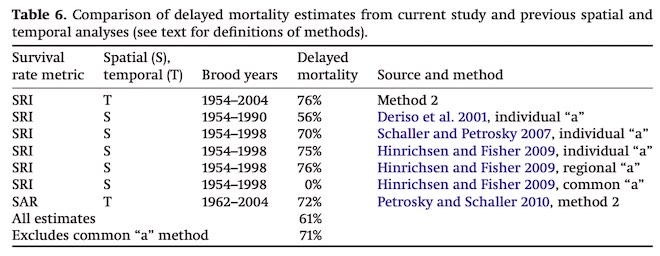forum
library
tutorial
contact

Northwest RiverPartners Peddles Its Snake River
Dam Disinformation in the San Juan Islands
by Sharon Grace & Chris Pinney
San Juan Islander, November 9, 2020
|
the film forum library tutorial contact |

|
Northwest RiverPartners Peddles Its Snake River
by Sharon Grace & Chris Pinney
|
Using cherry-picked data, Kintama concludes that since chinook are declining similarly West Coast-wide
(an unproven contention), Snake River dams cause little harm to salmon.
 On November 2, 2020, the San Juan Islander published a press release issued by Snake River dam lobbyist Northwest RiverPartners (NWRP), entitled New research reveals flawed approach to Salmon Recovery Programs - with major implications for dams debate.
On November 2, 2020, the San Juan Islander published a press release issued by Snake River dam lobbyist Northwest RiverPartners (NWRP), entitled New research reveals flawed approach to Salmon Recovery Programs - with major implications for dams debate.
NWRP's press release is part of a disinformation campaign designed to keep the four lower Snake River dams in place. This issue is important to the San Juan Islands. Breaching the salmon-killing dams is the single best action to recover abundant wild Snake River salmon and steelhead, and therefore help salmon-dependent Southern Resident orcas survive. The orcas contribute profoundly to the islands' atmosphere and tourist economy.
In its press release NWRP disingenuously promotes flawed "research" by Kintama Research Services, research that is funded by the Bonneville Power Administration (BPA), a federal agency that markets Snake River hydropower and opposes Snake River dam breaching.
Kintama claims that chinook salmon survival has decreased by roughly the same amount everywhere along the west coast of North America. Based on this claim, Kintama then jumps to the conclusion that chinook run declines are caused almost solely by ocean conditions. Using cherry-picked data from datasets developed by NOAA Fisheries and other federal agencies, Kintama then concludes that since chinook are declining similarly West Coast-wide (an unproven contention), Snake River dams cause little harm to salmon. Kintama's conclusion is remarkable, given that NOAA Fisheries has acknowledged as a defendant in federal court that the existence and operation of the dams account for most of the mortality of juveniles migrating through the Snake/Columbia dams.
Kintama also ignores that salmon declines in other West Coast rivers and tributaries have their own dependent and interdependent human-caused impacts — pollutants, mines, cities, habitat destruction, dams, overfishing or other destructive activities. If Kintama were correct that dams do not harm fish, we would not see salmon populations rebounding in many rivers where dams have been removed, such as on the Elwha River here in Washington and the Rogue River in Oregon.
The gold standard of salmon survival and recovery is smolt to adult return ratios (SARs). The Snake River averages adult return ratios of less than 1%. Recovery of depleted runs requires returns of 4-6%. Survival requires returns of 2%. Returns of less than 2% ultimately lead to extinction. In claiming that chinook runs are failing similarly along the entire West Coast, Kintama fails to mention that a number of coastal river and inland Columbia River tributary stocks have SARs of 6-10+%. These stocks do not have to pass eight dams, as Snake River salmon must.
Kintama also dismisses, with little explanation, delayed mortality as a cause for declining Snake River salmon runs. Delayed mortality is a term that describes dam-caused stress or injury to fish that manage to make it through the dams, but that make the fish easy targets for predators below Bonneville dam, or cause early death in the estuary or ocean. Scientists, including those at NOAA and other federal agencies, accept that the Snake River dams cause delayed mortality.
Notably, Kintama, in its abstract, advertises for more special interest funding for further "research," stating "we call for a joint systematic review by major funding agencies to further assess the broader consistency and comparability of SAR data with our findings." This is a clear clue that Kintama's work is strongly biased.
Kintama's paper is not based on sound science, but instead is pro-dam propaganda paid for by the dam industry and promoted by NWRP. It should be called out for what it is, especially because the salmon issue deeply affects the islands.
Related Pages:
A synthesis of the coast-wide decline in survival of West Coast Chinook Salmon by David Welch, Aswea Porter, Erin Rechisky, Fish and Fisheries, September 17, 2020
learn more on topics covered in the film
see the video
read the script
learn the songs
discussion forum
